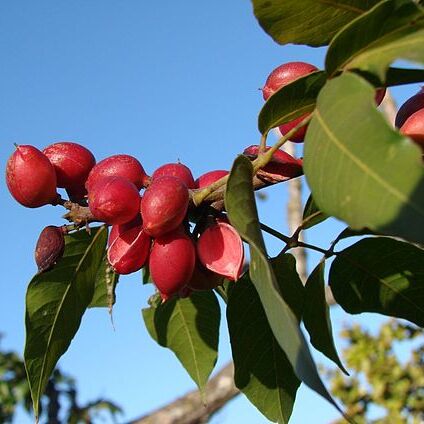Small trees. Branchlet pith without vascular strands. Leaves odd-pinnate, alternate, exstipulate; leaflets with petiolule, apex cuspidate. Flowers in axillary or terminal panicles, unisexual, bisexual, or polygamous. Calyx cupular or campanulate, shallowly 4-or 5-lobed, lobes imbricate in bud, recurved, persistent but not enlarged in fruit. Petals 5, valvate, apex incurved in bud, later recurved. Stamens as many as or 2 × as many as petals or more, distinct, inserted outside of disk, reduced in females but probably fertile; disk fleshy and thick, glabrous, flattened in male flowers, annular or cupular in female or bisexual flowers, grooved; filaments glabrous. Ovary 4-or 5-celled, glabrous or pubescent, globose or ovoid, reduced in male flowers; ovules 2 in each cell; style short or long; stigma capitate or shallowly 4-or 5-lobed. Drupe globose, ovoid, or somewhat compressed, apex with rudiment of style; pyrenes 4 or 5 (some often degenerated), rarely 1 or 2, bony with thin coat; cotyledons folded, palmate.
Trees, occasionally shrubs. Pith of the branchlets without vascular strands. Leaves without stipules; pith of the petioles without vascular strands; tips of the leaflets usually distinctly mucronulate. Inflorescences axillary, sometimes pseudo-terminal. Flowers 5-4-merous, possibly not always fully unisexual. Sepals more or less connate. Stamens twice as many as the petals, free, in female flowers very slightly reduced, possibly sometimes fertile. Disk intrastaminal, annular, truncate to undulate, glabrous. Pistil isomerous, glabrous or pubescent, in male flowers usually slightly reduced, often with sterile ovules in the cells. Fruits drupaceous, globose to ovoid, when dry the number of lobes coinciding with the number of developed stones; pericarp fleshy, containing the thin-walled, bony pyrenes; usually 1 or 2 cells nearly totally reduced; calyx persistent, not enlarged, lobes reflexed. Cotyledons plicate, lobed to palmatifld.

